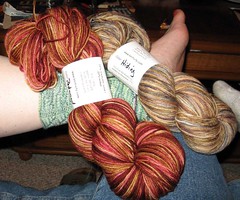Today we'll start to talk about teaching new knitters to cast on. But first, enjoy my new sock yarn. Perhaps they aren't the most splashy, but they have much subtle beauty. Both are from Knitivity.com, hand dyed in Houston, Texas (which meant I paid sales tax, which I would only do if I really liked something).
The one onf the right is "Hiding" and is supposed to be desert camoflage coloring, but I see the river rocks where the river meets the sea in Ireland, with the tans, grays whites and bits of black. The other is "Redwood," and is supposed to look like, well, redwood. It does, but when I saw it, it was much more "red" than I thought it would be from the website. And there is more gold than brown. This is all most excellent to me. The colors remind me of the warmth of the media room we just decorated in our house--the walls are a deep red and a dark gold.
I'd love to see either of these in worsted weight (I will tell Ray, I promise). An afghan with the Redwood and a denim color would perfectly coordinate with my media room, and I can see that Greenjeans cardigan I want to make so badly in the Hiding colorway--it would go with any neutral.
So, Which Cast-On to Teach?
Hey, you! Your feedback is most welcome here--I'd love more ideas to incorporate, so do not hesitate to suggest additions in the comments, or give me your opinions. I'd love them!
Some people don't teach new knitters to cast on. They cast on for them, and often they knit the first row for them.
If I were using the backward loop cast-on I'd probably do the same. It is so hard to knit the first row after backward-loop, and I usually knit into the back of the stitches on that row, too, so that would confuse a new knitter.
But, I don't use the backward loop cast-on. Why?
1. It's hard to knit the first row.
2. It is very hard to cast on loosely enough to not affect the finished product.
3. I don't like the way the edge looks very much.
4. it doesn't build the new knitter's confidence.
Some people like to teach one of the long-tailed cast-ons. Now, this is the one I use most for myself, but I don't teach it first. Why?
1. Guessing how much yarn to reserve intimidates new knitters.
2. It LOOKS so complicated (though later I will share my "easier" way of doing it).
3. It is also pretty easy to do tightly, though easier to get a good gauge than backwards loop.
I like to teach a knitted cast-on (that's what I call it, anyway). Why?
1. It starts them right off using the needles.
2. It is fairly easy to get a loose gauge.
3. Most important: it's a lot like actual knitting! Once they get how to do this, they are almost knitting already--it builds success.
Next: teaching the knitted cast on (I am out of time today, sorry).


I almost always use the knitted cast on for my projects. One too many mess-ups judging the amount of tail for the long-tail!
ReplyDelete